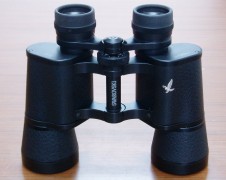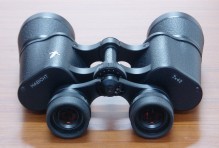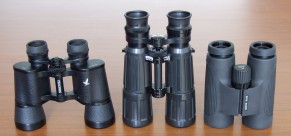

The 7x42 represents an interesting species of binoculars, combining excellent low light performance with a reasonable degree of mobility. In fact, they are much less bulky than typical glasses of 7x50 or 8x56 size, and with 6mm exit pupil vs. 7mm they perform almost equally well under dim light.
Some binoculars users go even further and adopt the 7x42 as their all-around glass, an alternative to the more conventional 8x42. Among the benefits are its wider field of view and the easy-going way of observation which comes along with the steady image and the large depth of field of 7x binoculars. This review compares the Zeiss 7x42 Dialyt, a classic high-end binocular made around 1990, with two current representatives of the upper middle class, Swarovski Habicht and Docter B/CF. The latter is of 8x42, and hence this test is also addressing the question of how far the 7x42 could replace the 8-power glass as an all-around binocular. All three candidates are currently available for 600-700 Euro (the Zeiss, of course, is discontinued and found only second hand), making this test a fair competition of two recent generations of optical instruments.
Fig. 1: The Swarovski 7x42 Habicht, current production
The 7x42 Habicht is made by the Austrian manufacturer Swarovski. With its magnesium body, sealed to be fully water proof and nitrogen filled, and coated with the help of latest technologies, this binocular is among the few representatives of state of the art Porro-prism designs on the market. The designer's choice to restrict its field of view to a minimum may be disputable, but it allows to keep the prisms slim and leads to an amazingly low weight of this instrument. There exists also a rubberized ('GA') version for particularly rugged applications. This binocular was already tested in an earlier review, and costs about 600 Euro (GA version: 700 Euro).
Fig. 2: The Zeiss 7x42 B/GA Dialyt, made in 1988
This binocular was introduced by Zeiss in 1981 and quickly gained the reputation of being an outstanding performer, even when compared to other members of the Zeiss line. Its body appears tall for a 42mm binocular, a result of Abbe-Koenig type prisms which build long, but, in contrast to the more compact Schmidt-Pechan type, fold the light-cone by total internal reflection only. Consequently, they do not require any mirror-coating at which light would get lost, making an exceptionally bright image when compared to other roof-prism designs of that time. Since 1988, the phase-correction coating (also called P-coating) was implemented, which shifted the level of contrast to that of the better Porro prism binoculars. The present sample was made around that time and already contains the P-coating. Later versions were called 'ClassiC', and finally discontinued in 2004, when the Victory FL emerged. Nowadays, the Zeiss 7x42 Dialyt is found second hand for typically 600-700 Euro (in its later, P-coated version).
Fig. 3: The Docter 8x42 B/CF, pre-2008 version
The B/CF series, which also contains the 10x42 B/CF, was designed around 2000 by Docter in Eisfeld. Although it is sometimes claimed to be a successor of the famous Zeiss Jena Notarem, the similarities are few and I suspect that these binoculars were actually designed from scratch. The 42mm objective is a quadruplet, i.e. made of no less than four lens elements. Further features include spectacle-friendly oculars (B), twist-up eye-cups and a central focuser (CF). This binocular is nitrogen filled, fully sealed with internal focuser, and specified to be submersible up to 3m. Its extra-rugged rubber armor makes this binocular feel like a Mil. spec. device and no doubt it is made for applications under most demanding conditions. The price tag in Europe is between 600 and 700 Euro, but I have occasionally seen considerably lower off-sale prices in US. Remark: In late 2007, an upgraded version of the Docter B/CF was introduced which is featuring improved coatings on lenses and prisms. In this test, I was using the old version of this binocular.
 Fig. 4: The Swarovski Habicht, Zeiss Dialyt and Docter B/CF
Fig. 4: The Swarovski Habicht, Zeiss Dialyt and Docter B/CF
The following table summarizes some of the specifications of the contenders.
| Real angle | Apparent angle | Eye relief | Exit pupil | Weight | |
| of view (deg) | of view (deg) | (mm) | diam. (mm) | (Gram) | |
| Swarovski 7x42 Habicht | 6.4 | 45 | 14 | 6.0 | 620 |
| Zeiss 7x42 Dialyt | 8.6 | 60 | 18 | 6.0 | 800 |
| Docter 8x42 B/CF | 7.5 | 60 | 16 | 5.3 | 800 |
Image sharpness: As usual with binoculars of decent quality, sharpness is a non-issue within the central part of the image, since any of them is doing perfectly well here. Towards the edge, the Dialyt, with its large true field of view, has to carry a heavy burden, but this problem has been masterly solved by the optical designer: A star image, being point-like close to the center, develops some blur when shifted to the edge, but very gradually. In fact, it is quite difficult to fix a point from which onwards the star might be called 'blurred', it happens somewhere between 60% and 70% towards the edge. This implies that during daylight observations, the aberrations remain almost unnoticed except near the edge. The Docter is able to keep any image blur outside the 75% radius, beyond that, the star image is degrading more rapidly. This is an excellent performance for a wide angle 8x42 binocular, and for sure the investment into sophisticated quadruplet objectives is paying off here. The Swarovski provides an even better edge sharpness: Up to about 80% the stars remain point-like and at the edge they are still of tolerable shape. Of course, one has to recall that the Swarovski's field is so narrow that critical areas of the field were excluded from the very beginning, and it is likely that the optical design did not require anything more than ordinary 3-lens-element reverse Kellner oculars. The Docter, if cut down to 45 degs., were sharp to the edge, and the Zeiss almost so.
Image color: All three binoculars deliver a neutral image color. There are some minor differences: Both Zeiss and Docter produce a somewhat warmer tone, a little towards yellow, while the Habicht appears to be absolutely white, if not a tad bluish. None of them has got any objectionable color tint, however. The Zeiss does in fact produce an excellent bright image, but the more recently built competitors are able to deliver the same level of brightness and contrast.
Rectilinear distortion: All three binoculars show a moderate amount of pincushion distortion as it is commonly employed to compensate for the globe effect and to provide a smooth panning of the image.
Stray light: Under difficult viewing conditions, especially at twilight, light from sources outside the field can enter the objective lenses through a large angle to illuminate the tube walls and is, partially, scattered into the optical path. The prevention of such a diffuse stray light is a particular strong side of the Dialyt, achieved with an array of perfectly placed internal baffles and prism shields. The Habicht is doing almost equally well, especially if stray light from above is involved, usually the most notorious cause of trouble, when the sky-glow interferes with observations of shadowed areas on the ground. The Habicht is, however, a little sensitive to stray light from the side, which can be easily confirmed when observing areas of the night-sky around the moon. The Docter can develop a faint diffuse ring in the outer areas of the field, particularly after sunset when the eye-pupils begin to expand and to touch the edge of the exit pupil. However, the level of stray light remains very low and does not compromise the contrast within the central area of the image.
Ghost images: If, at night, a bright object (street lantern, moon) is positioned into the field, reflections on the air-to-glass surfaces take place, which can lead to multiple 'ghost' images of the light source. At this point, the age of the Zeiss Dialyt (made in 1988) comes into play: Once a sufficiently bright lantern is observed, a colorful array of faint ghost images is produced. The number of these ghosts reflects the sophisticated and complex ocular construction of the Dialyt. A similar effect shows up through the Docter, but it requires a somewhat brighter light source to achieve the same ghosting experience. This is a nice demonstration of the advance in coating techniques over the last 10+ years: While assuming that the Dialyt's T* coating was state of the art in 1988, we may claim the upper middle class of the early 2000s to be coated even better. This is all the more true for the Swarovski, delivering a perfect image of the same lantern which causes trouble with the Docter and, more so, with the Dialyt. I also assume that later samples of the Dialyt are likely to offer further improved coatings and therefore perform better in such a test. To be fair, it should be pointed out that the level of ghosting displayed by the Dialyt is low - in real life applications, these effects are not likely to create any objectionable degradation of contrast.
Low light performance: The Zeiss and the Swarovski are performing equally well here. With 6mm exit pupils, these are specialists for low light, and they are also well protected against stray light, delivering maximum contrast under most difficult light conditions. The Docter, with 5.25mm exit pupil, is naturally a little behind in this discipline, but nevertheless an excellent performer for such a type of binocular. The combination of excellent coatings, good stray light protection, and its wide and bright image allow the Docter to perform well even under deep twilight conditions.
| Angle of | Image | Stray | Ghost | Low | Image | Mechanical | Final | |
| field | sharpness | light | image | light | color | construction | score | |
| Swarowski 7x42 Habicht | 1 | 3 | 2 | 3 | 2.5 | 2 | 1.5 | 15 |
| Zeiss 7x42 Dialyt | 2.5 | 1 | 3 | 1 | 2.5 | 2 | 1.5 | 13.5 |
| Docter 8x42 B/CF | 2.5 | 2 | 1 | 2 | 1 | 2 | 3 | 13.5 |
The 'final score' is the sum of the individual scores and is intended to serve as an orientation only.
The above 'warning' not to take the scores too seriously is particularly true for this review. I would go so far to claim the optical performance of all three contenders being equally excellent, and most of the apparent differences mentioned above are of little, if any, relevance for practical applications. These are good binoculars, and the task to distinguish their stray light, ghost images and edge sharpness is running the risk of becoming an exercise in hair-splitting rather than being a field test of practical relevance (check also the No. 6 of the collected wisdoms). As an example, imagine the lens-coating being further improved, then it would just require a lantern of higher intensity to produce the ghost images. If further improved, we had to come closer to generate the same effect. But does it matter for those applications in which we are not interested in studying the internals of a light bulb during nighttime? Most likely, not.
The good thing is: Instead of being forced to study the optical merits of these binoculars, the potential buyer may peacefully focus on practical questions: Am I willing to carry around 800g? If not, the Habicht is the right choice, and in fact it could turn very difficult to find a night glass of less than 620g. Am I willing to live with a tiny field of view of 45 degs.? If not, the Habicht is out. Do I need it for marine use? If yes, the Zeiss is out. Do I need particularly high low light performance? If yes, the Docter is out. Further criteria might include the type of eye cups, the focuser, usability with eye-glasses, the manufacturer's warranties or simply the look and feel of the instrument. My personal impression? I respect the level of perfection realized with the Habicht, and I admire the high level of engineering put into the Docter, and, somehow, I love the Dialyt - don't ask why! If there existed a discipline called 'ease of view': The Zeiss would score high there.
A question stated above was addressing the suitability of 7x42 binoculars as substitute for the all-around 8x42 size. I don't see any obstacles, but I would choose the 7-power if and only if it delivered a wider field than the 8x binocular of interest. Since I can hold 8x binoculars steadily enough, image stability won't be a reason for me to sacrifice magnification. One has to consider that the 7x binocular will usually show more aberrations, at the same apparent angle, than its 8x counterpart, a result of its wider (true) angle of view. On the positive side, its superior low-light performance may turn out to be an important feature under certain conditions.
This review indicates that recently made binoculars continue to benefit from technical improvements. As a result, today's second line of binoculars, represented by the Docter B/CF and the Swarowski Habicht, is fully competitive with the high-end of the late 1980s, as represented by the Zeiss 7x42 Dialyt, and in some aspects, like lens coating or water resistance, they are even a bit ahead. In turn, this Zeiss is by far superior to another Zeiss 10x40 Dialyt of the 1970s, which again was a high performer of its time, but only singly coated and without the P-layer.
Holger Merlitz: merlitz@gmx.de
Last updated: Oct. 2006